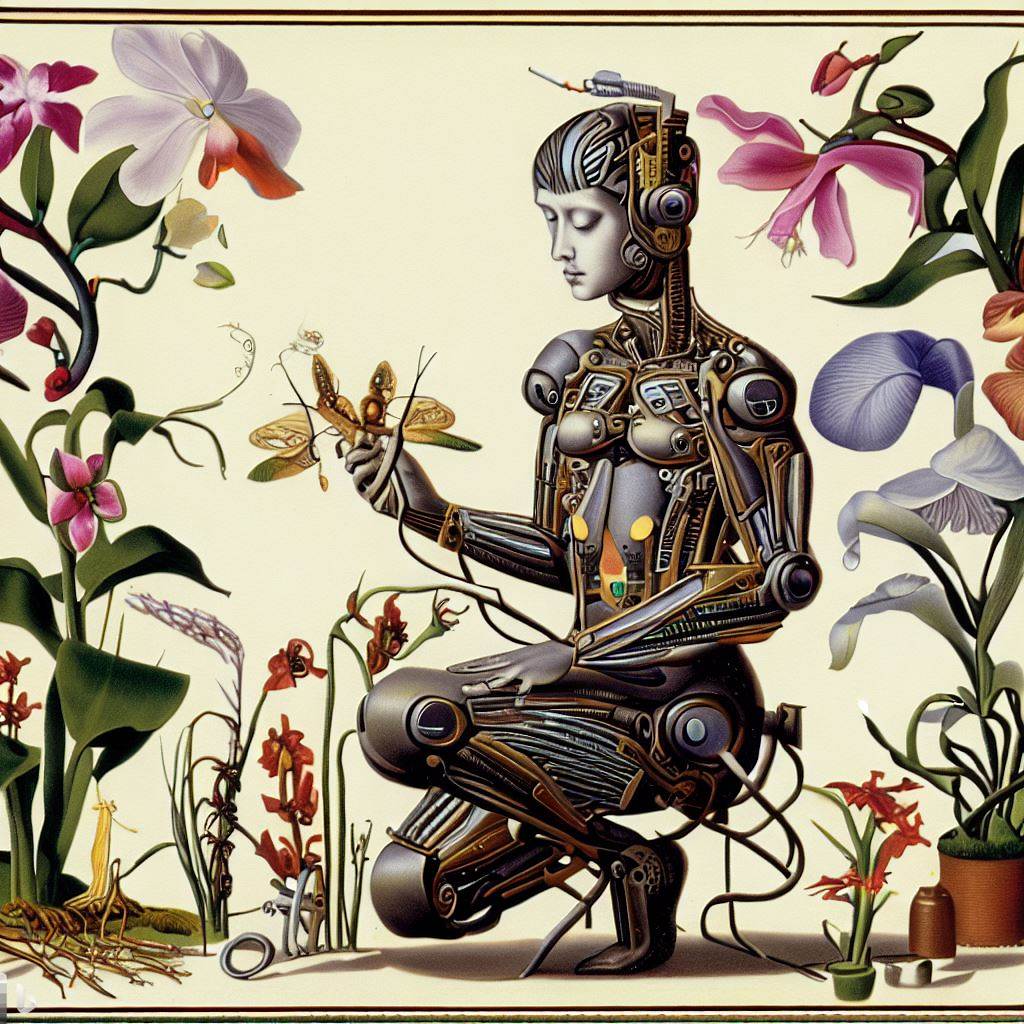
Communication, free culture and copy in the age of Artificial Intelligence
This text comes from the class of 24 march of 2023 in PPGCOM of UFRGS (Graduate Program in Communication at Federal Universisity of Rio Grande do Sul, Brazil). Originally published in Portuguese in april 2023
Two years ago I launched, during the pandemic, the book “The Culture is Free: a history of anti-proprietary resistance,” the result of almost 10 years of research with BaixaCultura – online laboratory, collective, blog. The book was born as an attempt to conceptualize, situate and contextualize free culture, an idea that spread from free software in the 1990s and gained prominence with the discussions around the free sharing of files (“piracy”) on the Internet in the 2000s. For this, the work done was that of a genealogy that recovers part of the circulation of cultural goods in antiquity, the great transformation of the invention of Gutenberg’s printing press in the Middle Ages, and the subsequent rise of Capitalism with the mode of production having property as its basis. From this originated the notion of intellectual property, which resulted in the consolidation of cultural goods as merchandise and copyright as the system to regulate these goods, starting in the 19th century. It also gave birth to some of the resistances to this system, especially in the artistic and political avant-garde field of the 20th century, first in more conceptual terms, such as the works of Dada, the French situationists of the 1950s and 1960s, then also in practical terms, especially in punk rock and the fanzine and mail art culture of the 1970s. What would hip-hop and rap be if it were not for the disrespect of intellectual property in the creation of samplers?
These 20th century movements also accompanied the remarkable proliferation of technological means of reproduction – from the photocopier to the VCR, from record players to cassette tapes – and the rise of the so-called mass media, with film, radio, and TV becoming part of the daily lives of billions of people. I portray some of this period and the reproduction technologies from the beginning of the 20th century until the computer in chapter 4 of the book, not by chance called “Recombinant Culture”.
Near the halfway point, the book finally reaches the 1970s, the creation of the personal computer, free software, and two decades later, the internet. From there it focuses on the discussions around free culture starting from the concept of copyleft, one of the great hacks in the intellectual property system created in the 19th century. I wrote on page 149: “As a pun or literally, copyleft was the concept, expressed in the GPL license and others linked to the GNU Project that follow it to this day, of requiring legal ownership in order, in practice, to relinquish it by allowing everyone to make whatever use they want of the work, as long as they pass on their same freedoms to others. The formal requirement of ownership means that no one else can put a copyright on a copyleft work and try to limit its use”.
From copyleft originates, in the early 2000s, Creative Commons, a set of licenses (and an NGO) that will help expand the idea of free culture and free knowledge worldwide, also giving rise to the Open Education, Open Science and OpenGlam (“open galleries, libraries, archives and museums”) movements, still active today. The discussion (and also the criticism) about free culture is followed by the transformations in Internet and digital communication, in which the “human” curatorship – random and loose, exemplified by the habit of flanking through blogs and websites, common practice of Internet users in the 2000s – is gradually being replaced by algorithmic curatorship. What can be seen mainly from the consolidation of social networks – especially with Facebook’s “Timeline” model (which will influence other networks from the 2010s on) and streaming as algorithmic systems of selection and recommendation of information and content of predominance on the Internet.


In the end, “Culture is Free” brings the perspective on the question of free culture and knowledge to other modes of existence than the hegemonic Western one, seeing how Amerindians and peoples from the far east (like the Chinese) have to this day historically very distinct notions about what is intellectual property, copy and original, open and collective knowledge. With these perspectives I try to remember that there are ways of seeing the world, present in many traditional places and communities, that who oppose with certain Western ideas and ways of acting notion that created intellectual property.
For example, in China, I talk in the book about “Shanzai,” a Chinese neologism created in the 2000s to say what is fake. It ranges from literature to Nobel prizes, MPs, amusement parks, tennis, music, movies, stories of the most diverse kind. At first, the term referred only to smartphones or counterfeit products made by brands such as Nokia or Samsung and sold under the name Nokir, Samsing or Anycat. Soon, however, they expanded to all areas, in plays that, in the manner of Dada, used creativity and parodic and subversive effects with the “original” brands to create other names – Adidas, for example, becomes Adidos, Adadas, Adis, Dasida… They are, however, more than mere fakes: their designs and functionalities owe nothing to the originals, and the technical or aesthetic modifications made give them an identity of their own.
The commodity system known in the West is, as is well known, different for the perspectives of traditional peoples – it is no accident that Davi Kopenawa calls us white people the “commodity people” in the monumental “The Falling Sky“. In the words of anthropologist Marilyn Strathern (1984), it is the opposition of the commodity economy, in which people and things take the social form of things, with the gift economy, in which people and things take the social form of people. As I wrote on p.216 of the book, “It is in this sense that, in originary societies in various parts of the world, the model of property (particularly intellectual property), based on the relation of the work of art as a commodity of consumption, becomes insufficient to deal with the more durable and complex relation of the circulation of objects. In the cultural system of the original societies, it is perceptible, for example, the centrality of collective values, linked to the plurality and survival of the community, in relation to individual values, of exclusive use and individual choice. This, in turn, makes it more difficult for cultural and knowledge goods in this context to become just another commodity sold as merchandise, because there are principles and responsibilities of reciprocity and solidarity that seek to value the moral substance itself – which we could also call “soul” – of the objects in their relations with people and the world.
From this brief panorama, we can finally ask ourselves: how can we talk about original and copy if a two-thousand-year-old culture from the Far East encourages reproduction and treats its content and permanence as more important than the origin of an idea, even if modified and reinvented in each context? Or how can we say that there is only one human owner of ideas when for many native peoples, among them some Amerindians, there is no separation between subject and object as we know it in the West, and the creative subjectivity, to whom one should attribute the “authorship” or the “ownership” of goods, is distributed in a vast network that includes people and objects, nature and society in an almost symmetrical way?
AND WE FINALLY GET TO AI
It is in the discussion about copy and original that we finally get to the hottest discussion of the moment, artificial intelligence. With the growing popularization of generative Artificial Intelligence systems (which are able to generate text and images autonomously), such as ChatGPT and MidJourney, it seems that we are heading for another historical moment to discuss both digital communication and free culture and knowledge, copyright and intellectual property. Some computational researchers indicate that soon the amount of text/image generated by AIs tends to surpass all human production. It’s not hard to imagine: based on machine learning, the potential is tending to be infinite for creating works. But given that these systems work primarily with new presentations of ideas that have already been generated (and recorded on computers), is it possible to recognize the sources and identify the authorship of an information brought by these AIs? Will “artificial” systems – and also “human” systems, or would it be better to say for both “hybrids”? – of information control will be able to impose limits to this proliferation and check the veracity of what is reported? How can we speak of copy and original in a world increasingly dominated by multiple copies reproduced ad infinitum by “intelligent” algorithmic systems?
I propose, of course, more questions than answers. Both because it is still an initial research, which is starting as, say, formal academic research, structured from FGV ECMI, where I work today as a researcher and professor. But mostly because nobody knows yet how to answer these and other questions about AIs; the very companies that are at the leading edge of this discussion in 2023, like Open AI, are learning about the impacts of the systems they create from feedback from millions of users. The responses and different uses invented by people bring new responses and new hallucinations from the systems, which are having to be corrected in almost real time.
There is, of course, a great risk in experimenting live with a technology that has such a transformative impact on information production, and it is no wonder that the discussion about AI ethics has been one of the big issues in debate for some years (or decades) now. The ONU has already given recommendations, in 2021, to suspend the use of AI in facial recognition systems until there is regulation on the use of the technology, just as recently a letter signed by over a thousand experts and personalities, such as Steve Wozniak, co-creator of Apple, Yuval Noah Harari, famous historian, and the unscrupulous billionaire Elon Musk, called for a moratorium, a “mandatory stop to think” about the consequences of the unbridled development of AI, especially generative ones like ChatGPT.
I like the image created by one of the best texts of the many that have been published on the subject between January 2023 and now. It is called “ChatGPT is a blurry JPEG of the Web” and was written by Ted Chiang for the February 2023 New Yorker.
“Think of ChatGPT as a blurry JPEG of all the text on the Web. It retains much of the information on the Web, in the same way that a JPEG retains much of the information of a higher-resolution image, but, if you’re looking for an exact sequence of bits, you won’t find it; all you will ever get is an approximation. But, because the approximation is presented in the form of grammatical text, which ChatGPT excels at creating, it’s usually acceptable. You’re still looking at a blurry JPEG, but the blurriness occurs in a way that doesn’t make the picture as a whole look less sharp.”
The image of the blurred JPEG helps us understand that the system created by Open IA “swallows” (almost) the entire internet and regurgitates by rephrasing what it has swallowed, not word for word. That despite inventing references and other wrong information (those who have used it have certainly been surprised with a book, a non-existent article), it does not “lie”, but writes “probable” answers – or “blurbs”, following the metaphor – based on the weights and calculations made from each token (input) generated. There are thousands of recombinations of ideas that have already been generated by the human mind, shown from a statistical analysis of a gigantic database. A database that, giant as it already is (and we are not sure how giant it is, another big problem caused by the lack of transparency), tends to grow more and more, fed by information collected on the web without authorization. Do they need to have authorization for this? Doesn’t data collection further reinforce datacolonialism, the unequal extraction (and exploitation) of data from the global south?
Other questions I bring here today give a taste of the transformative potentialities, for “good or bad,” of generative AIs also for the discussion in communication and circulation of information and cultural goods:
If on the one hand the increasing use of generative AI systems in everyday work favors users (including in the creation of new “occupations” such as design or prompt engineer), on the other hand it is a competitive problem for intellectual creators, especially for those kinds of so-called functional creations, such as a poster for an event, a “card” for a social network, a track for a short advertising video, an illustration for some work;
The problem of market concentration, just like big tech today. AI companies need a high initial investment, but a low maintenance cost to keep producing works and increasing supply, which is done without being accompanied by a proportional increase in demand (this issue I bring from the book by Pedro Lana called: “Artificial Intelligence and Authorship: Issues of Copyright and Public Domain“, released this 2023)
_ The “appropriation” of the common space (public domain) of ideas. A very large number of works produced can exhaust the amount of possible expressions of an idea in a certain medium – music, for example, where there are already cases of AIs, such as Google Assistant, which recognizes the samplers of a song, excerpts of even less than 1s. Identifying can also mean controlling and restricting; anyone who has ever uploaded a video with a song protected by copyright on Youtube, Instagram or any other platform knows how, for the justification of “defending property”, technology companies already identify and quickly bar the circulation of information. Would hip hop have been born if all samplers used were identified, controlled and restricted? Brazilian rapper Don L saw this danger and wrote on Twitter: “capitalism will end up with the art of the sample. i am totally against having to pay for samples unrecognizable by a human. if you go by this logic, there should be copyrights for instruments. pay for yamaha, korg etc in every song kk”.
_ The biases, the hallucinations; and the sources? Again: where is the transparency?
Here are perhaps some of the biggest problems today. They involve, for example, the biases, hallucinations, mistakes made by ChatGPT and exploitation of workers to manually “correct” the AIs, which make us glimpse a scenario closer and closer to a “Dark Digital Age”.The history of fascist hallucination of the last AIs is not the best; will it be different now? If so, how? What regulatory measures are possible to prevent these machines from turning into racist, misogynistic, and fake news propagating monsters? There is a lot of discussion on the subject, especially about possible legislation – some of which I brought up in this text from BaixaCultura. It is worth following the work of the Rights in Network Coalition, which is involved in this and other important issues in defense of digital rights.
On the legal side, it is also worth remembering fair use, fair use and its limitations and exceptions that have become one of the legal pillars on which AI applications depend. Its defense and amplification, as Lukas Ruthes Gonçalves says in this text, “are paramount so that creators and inventors can continue to recombine existing knowledge to create new and exciting possibilities, as they did before with the camera and image editing programs like photoshop.
Finally, I recall Benjamin to remix an already classic question: how does one identify a work of art in the age of its “algorithmic reproducibility”? If, as Hal Foster wrote in “What Comes After Farce?“, the negative force of automation is less the loss of “aura,” as Benjamin believed, and more the loss of “individual risk” and “communal participation,” what would we say of processes that are not only automated but autonomous? For that matter, how autonomous are these systems? Another question: is the work of art only the fruit of the human spirit? Has the time come, as the indigenous people have been doing for a long time, to review anthropocentrism, giving the status of creators to non-human, “artificial” or “natural” beings? Would reviewing the anthropocentrism in intellectual property be the end of copyright as we know it today?
That’s a lot of questions, I leave it to you to bring more others. Thank you!”
[Leonardo Foletto]
*Image created in Stable Diffusion from the prompt: An androgynous cyborg hybrid of machines and living organisms, with lots of plants, animals and insects, tending to a digital orchid, in 19th century Italian naturalist style




Deixe um comentário